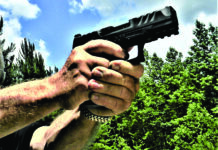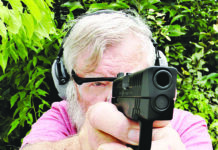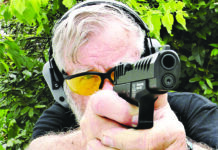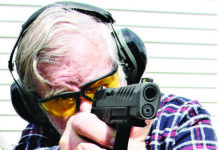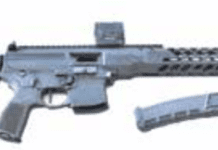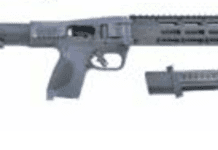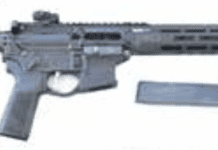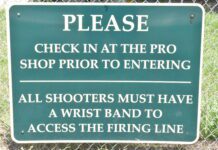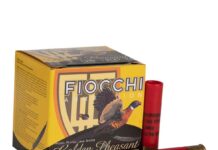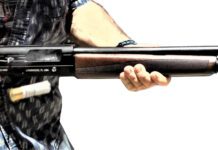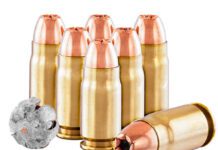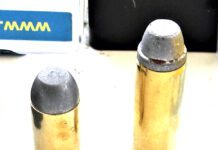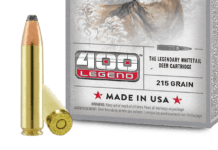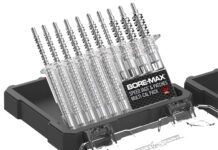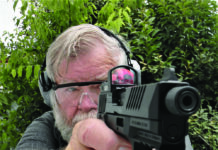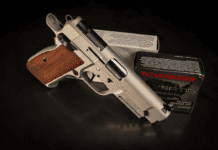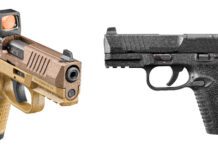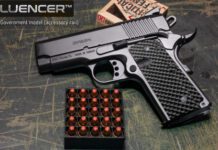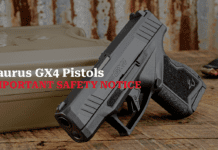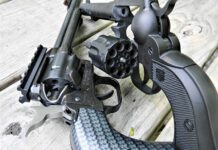9mm Pistols: Uzi Mini Pro, MPA Defender, and SIG Sauer MPX-P
The civilian-available semi-auto versions of what began as expensive SBR's (short-barrel rifles) or true submachine guns are advertised as having good accuracy and reliability while offering a more compact package than a rifle and higher round counts than most handguns. For the task of guarding the castle, we've been around the block a time or two, and have suitable choices for nearly anyone — great pistols, rifles, and shotguns. For this test, we had to suspend any preconceived notions of what we might prefer for home defense and test these firearms based on their own merits. Those merits, we found, are few. If you are shooting for fun and simply making brass, anything that goes bang is suitable. We'll get into the reasons for these judgments, but we like to be clear up front. The SIG Sauer MPX-P is one expensive means of not accomplishing much. The Uzi Pro pistol has drawbacks that made shooting downright frustrating. The MasterPiece Arms Defender proved to be the best of the three and has merit in a defensive situation, within certain narrow parameters. We arrived at this decision by using personal-defense criteria as the overriding factor in providing Buy/Don't Buy advice to our loyal readers. So, in more detail, here are our reasons for making these assessments. Our 9mm Luger ammunition for this test included a 158-grain lead round nose choice from Tomkatammo.com ($18/50 rounds). We also used Black Hills Ammunition 124-grain jacketed hollow points from VenturaMunitions.com ($14/20), a Black Hills Ammunition 115-grain EXP, an Extra Power load not quite in +P territory, also available from VenturaMunitions.com, ($17/20), and a SIG Sauer 115-grain full-metal-jacket load from Cabelas.com ($28/50). Others included the SIG Sauer 124-grain V Crown jacketed hollow point from Luckygunner.com ($16.75/20), and the Hornady American Gunner 124-grain XTP +P from MidwayUSA.com ($14.79/20). We used the Tomkat 158-grain, the Black Hills 124-grain JHP, and the SIG 115-grain FMJ load in benchrest accuracy testing.
More Laments for Custom Guns
Like Grant said in last month's letters section, I, too, lament the passing of the pride of custom-gun ownership and the common look of the Ubiquitous Black Gun. But, as was said, black guns are cheap and proven reliable. Also, I cannot justify carrying a nice custom pistol on the off chance that I might have to use it. In that case, I would have to surrender it to the police, and then it would be months at a minimum to maybe get it back by jumping through their hoops.
Yes, I would rather carry a "Rolex"-quality sidearm, but I often think that if I had to give up my Valtro, I'd don't know what I'd do.
A black gun I can give up with no emotion, and go home and get another one. I always enjoy the magazine, from the editorial remarks to the last page. — Dave
Century Versus Diamondback: Affordable 9mms Butt Heads
The high-capacity 9mm handgun continues to be a popular personal-defense choice, for good reason. Many of the finest handguns in the world are chambered for the 9mm Luger cartridge and nothing else. In a handgun of 30 ounces or so, loaded recoil is light to manageable. Practical accuracy may be outstanding. A magazine capacity of 15 rounds or more is reassuring and gives a good reserve of ammunition. With these considerations in mind, we tested two modern economy-grade 9mm handguns whose performance was acceptable, especially considering the price, though our shooters found we liked one pistol better.
These two handguns are large for concealed carry, but they are light enough and may be concealed with enough effort and an intelligent holster choice. Certainly, they can be employed in the home, where overall size is less of an issue. Those firing and using compact handguns may not realize how easy bigger handguns are to use well compared to a pocket model.
One such larger handgun that is affordable to boot is the Century Arms TP9SA, which is listed in the company's catalog as SKU HG3277-N. A similar desert tan model is HG3277D-N. We found one selling for $346 atBudsgunshop.comand another one on sale at Cabela's for just under $300. This handgun is manufactured by Samsun Yurt Savunma, a Turkish gun maker, and imported by Century Arms of Delray Beach, Florida. The TP9SA and many of its accessories are marked "Canik," for the Canik 55 division of the manufacturer. So, to be plain about it, the Century Arms TP9SA is a Canik 55 9mm pistol, similar in outline to the Smith & Wesson SW99 and Walther P99. There are enough differences between the Canik and the Walther pistol to say the former is not a clone of the latter, but the Century import is obviously similar to a comparable Walther, being a service-size 9mm with a polymer frame and mid-length slide and a 4.25-inch barrel. Our second test gun was the Diamondback Firearms DB FS Nine DB9FS 9mm Luger, which lists for $483, but which we found at Budsgunshop.com selling for $265. Founded in 2009, Diamondback Firearms is based in Cocoa, Florida.
The Diamondback DB9FS is a striker-fired polymer-frame pistol that in general outline resembles the Glock 17. Our shooters noted that the pistol feels different than a Glock, and the overall configuration is markedly different than the Glock. Here's more about these two affordable 9mm pistols.
9mm Luger Snubnose Revolvers: Ruger LCR versus Taurus 905
The 9mm is the most popular handgun cartridge in the world, in use with most military forces and LE agencies; in fact the FBI announced in 2014 that it is switching back to the 9mm after having used the 40 S&W since 1997. When we think snubnose revolvers, we typically think 38 Special, but since the mid-20th century, revolver manufacturers have been building short-barreled wheelguns chambered for 9mm semi-automatic pistol ammunition. In the past we tested two such 9mm Luger chamberings, an S&W Model 940 (C+) and Charter Arms Pitbull (A-). We noted then that 9mm compact semi-automatic pistols have an edge over 38 Special revolvers due to the semi-automatic's higher round capacity, but in the revolver, the playing field between 38 Special and 9mm Luger is leveled, as far as round counts go.
Now, ballistic technology has made the once underperforming 9mm better. We have done a number of tests comparing 9mm and 38 Special ammunition from short-barrel handguns, and, generally speaking, the 38 Special runs bullets with weights from 110 to 158 grains at muzzle velocities of 900 fps to 1000 fps. The typical 9mm uses bullet weights from 115 to 147 grains at speeds of 910 fps to 1100 fps. So the 9mm has a slight performance advantage over the 38 Special. A bigger nod goes to the availability and affordability of 9mm ammo, which can be found nearly anywhere in the world, and which domestically costs about 17 cents a round compared to 25 cents a round for 38 Special.
There are other reasons to look at 9mms in wheelguns. We feel the ability to swap ammo between our semi-auto and our revolver makes sense, with only one type of cartridge to purchase. New shooters usually find revolvers to be less complicated to operate, so if your home-defense backup isn't familiar with semi-autos, you can still partner a high-cap 9mm semi-auto with a low-cap 9mm wheelgun pretty easily.
Though some testers groaned when they saw the 9mm revolvers in this test, saying they were as unnatural as three-wheel motorcycles, they put their prejudices aside and found these revolvers performed well at the range. The Ruger LCR Model 5456 9mm Luger debuted in 2014, and the Taurus 905 has been around since 2003. Unlike the Charter Arms Pitbull (which does not use moon clips, but instead employs a retention spring built into the ejector that fits under the 9mm cartridge's rim), the LCR 9mm and the 905, like the S&W Model 940, use five-shot moon clips. Moon clips have been the standard convention when chambering semi-automatic cartridges in revolvers since 1917, when 45 ACP was chambered in S&W and Colt's large-frame revolvers. Moon clips mean the revolver is fast to reload — nearly as fast as a magazine change in semi-auto. But, as we have found in the past, carrying a spare moon clip in one's pocket can lead to bent clips, making them inoperable. Not that this a show stopper, just an attribute of moon clips in general. So don't put a moon clip in your rear pants pocket and sit down. In fact we loaded both the Ruger and Taurus moon clips provided with the test guns and dropped them onto a concrete floor from waist height to see if the cartridges would fall out or the clips bend. A cartridge from each clip popped out after the drop, but there was no sign of bending. Another cost we looked at was how much moon clips go for.Brownells.comlists three moon clips for $12.99 (#780-001-371WB), less than one semi-auto magazine. The moon clips from Taurus and Ruger were not compatible with the other manufacturer's revolver. We should note that single cartridges can be loaded into the chambers of the Ruger and Taurus wheelguns and fired safely, since the 9mm case headspaces on a step in the chambers. In that case however, extraction without a moonclip requires each case be pushed out with a pencil, pen, or similar skinny object.
Century Versus Diamondback: Affordable 9mms Butt Heads
The high-capacity 9mm handgun continues to be a popular personal-defense choice, for good reason. Many of the finest handguns in the world are chambered for the 9mm Luger cartridge and nothing else. In a handgun of 30 ounces or so, loaded recoil is light to manageable. Practical accuracy may be outstanding. A magazine capacity of 15 rounds or more is reassuring and gives a good reserve of ammunition. With these considerations in mind, we tested two modern economy-grade 9mm handguns whose performance was acceptable, especially considering the price, though our shooters found we liked one pistol better.
These two handguns are large for concealed carry, but they are light enough and may be concealed with enough effort and an intelligent holster choice. Certainly, they can be employed in the home, where overall size is less of an issue. Those firing and using compact handguns may not realize how easy bigger handguns are to use well compared to a pocket model.
One such larger handgun that is affordable to boot is the Century Arms TP9SA, which is listed in the company's catalog as SKU HG3277-N. A similar desert tan model is HG3277D-N. We found one selling for $346 atBudsgunshop.comand another one on sale at Cabela's for just under $300. This handgun is manufactured by Samsun Yurt Savunma, a Turkish gun maker, and imported by Century Arms of Delray Beach, Florida. The TP9SA and many of its accessories are marked "Canik," for the Canik 55 division of the manufacturer. So, to be plain about it, the Century Arms TP9SA is a Canik 55 9mm pistol, similar in outline to the Smith & Wesson SW99 and Walther P99. There are enough differences between the Canik and the Walther pistol to say the former is not a clone of the latter, but the Century import is obviously similar to a comparable Walther, being a service-size 9mm with a polymer frame and mid-length slide and a 4.25-inch barrel. Our second test gun was the Diamondback Firearms DB FS Nine DB9FS 9mm Luger, which lists for $483, but which we found at Budsgunshop.com selling for $265. Founded in 2009, Diamondback Firearms is based in Cocoa, Florida.
The Diamondback DB9FS is a striker-fired polymer-frame pistol that in general outline resembles the Glock 17. Our shooters noted that the pistol feels different than a Glock, and the overall configuration is markedly different than the Glock. Here's more about these two affordable 9mm pistols.
9mm and 45 ACP XD Mod.2 Subcompacts Go Head to Head
The compromise that shooters have to deal with in choosing a concealed-carry sidearm is this: A smaller pistol that is easier to conceal is usually more difficult to operate and shoot; and a larger pistol that is easier to operate and shoot is more difficult to conceal. A line of guns retailers have told us are popular carry pieces are the newest Springfield Armory XD variants, the XD Mod.2 series.
They are supposedly redesigned XD subcompacts that have better ergonomics, more useful sights, and slimmer profiles. If you are looking for a concealed-carry handgun that offers a super-slim profile, less weight, and better concealability, we suggest you stick with a single-stack pistol like Springfield's XD-S 3.3, which we reviewed in February 2015 (Grade A). On the other hand, if you want a pistol that is still concealed-carry friendly but has nearly double the magazine capacity with the feel of a full-size pistol, the Mod.2 pistols are supposed to fill that ticket. So we tested the two most-popular chamberings of the Mod.2 pistols in 9mm Luger and 45 ACP to see what all the fuss is about. The question that needed to be answered is, are these new guns so good that we would recommend you considering switching from your favorite carry piece? That is a super-high barrier for any handgun to scale, and, ultimately, each concealed-carrier has to make the decision to try them on his or her own.
The trend these days with law enforcement is to move to the 9mm cartridge, and many agencies we are acquainted with are using 147-grain ammo. So we selected 147-grain cartridges from Atlanta Arms as well as 115-grain rounds from Black Hills and Hornady. For the 45 ACP, we stuck with the most popular bullet-weight choice, 230 grains, selecting FMJs from Perfecta and Federal and hollowpoints from Atlanta Arms. We had no experience with Perfecta 45 ACP ammo, but found it at a big-box store and thought we'd try it.
We fired for accuracy at 25 yards using the provided flush-fit magazines and a rest. We also fired for speed at 15 yards with both magazines, and with the flush-fit magazines drew from concealed carry using the included belt holsters and a Fobus IWB holster that uses either a large or small universal shell. The flexible backing of the Fobus ensures the pistol stays secure when worn. We practiced dry-firing drills with both pistols using both holsters and progressed to live fire. By no means could these pistols be dropped in a pants pocket; they need a holster.
Springfield Armory XD Mod.2 3.0-Inch Subcompact XDG9801HCSP 9mm Luger, $556
Both XD Mod.2s also have a slimmer frame that measures 1.19 inches for the 9mm model and 1.2 inches for the 45 ACP model, thinner than the 9mm XD 3-inch subcompact and only 0.2 inch thicker than the single-stack 9mm XD-S 3.3 model. Both the 9mm and 45 ACP Mod.2 pistols have heights of 4.75 inches with the flush-fit magazine, same as the XD 3-inch subcompact. The XD-S 3.3 model is 4.43 inches high, making the Mod.2 pistols just 0.3 inch taller.
Aft of the trigger on both sides the frame is a scalloped-out section so the trigger finger of a left- or right-handed shooter lays more comfortably in the ready position. The high beavertail safety and the rear of the trigger guard is relieved to provide a high hand hold on the pistols, making the bore axis closer to the shooter's hand. Team members with small-to-average-size hands, as well as those with large hands, found the Mod.2 pistols comfortable to grip. In some instances, testers had to curl their small finger under the floorplate, while others had enough grip to stay on the lip of the flush-fit magazine floorplate.
Range Data
The team was split even before we put in any trigger time, with the 45 ACP aficionados against the 9mm clan. But as range testing progressed, we found ourselves liking the 9mm more. At first, we expected the XD Mod.2 pistols would shift in our grip during recoil, but we found quite the opposite to be true. The grip textures offered good friction against our hands without abrasion.
We also saw the sights were large and offered fast target acquisition. The pistols likewise pointed well for close work and continued to perform out to 25 yards. Most felt the pistols acted like full-size pistols.
Recoil felt less stout in the Mod.2s compared to other smaller pistols we are familiar with. We attribute this to the grip, lighter slide, and dual-spring recoil guide rod. There was some take up on the triggers — which is fine considering these are defensive pistols — as long as the breaks were consistent, which they were.
With average accuracy of about 1.5-inch groups with the 9mm model and 2-inch groups with the 45 ACP at 25 yards, we were happy. The Mod.2 in 9mm was more pleasant to shoot than the 45 ACP, though the 45 ACP was nowhere near the brute we though it would be. We could also recover faster using the 9mm model, so a follow-up shot was quicker.
Handgun Stats: DoubleTap Defense Tactical Derringer 9mm Luger, $345
The pistol is so difficult to fire due to the heavy recoil, realistic practice is out of the question, at least for our shooters.
Range Data
To collect accuracy data, we fired five-shot groups off a solid bench rest. Distance was 5 yards. We recorded velocities with a Shooting Chrony Master Chronograph. The first sky screen was set 10 feet from the muzzle.
Derringer Shoot-out: DoubleTap, Cobra, American Derringer Co.
Meet the derringer, an anomalous little pocket pistol of which there are many types. Gun Tests tested 3 of these handguns to see if they are worth the purchase. Turns out, they might be better for show than for showdown. The original derringer was a product of one Henry Deringer, a 19th-century maker of small muzzleloading pocket pistols. His original Philadelphia Deringer percussion-lock pistols were usually 41 caliber and varied in length from 1.5 to 6 inches. The most notable use of a Deringer was by John Wilkes Booth, who shot President Abraham Lincoln. Once cartridge guns came into being, Deringer's name was misspelled often enough to become the generic description of a small pocket pistol of limited capacity, often with a sliding or pivoting breech block. They commonly carried two shots, although some were designed for up to four shots. They were sometimes called "muff pistols" because they were carried in a muff or hand warmer used in the winter. Also, the derringer became a backup favorite of Western marshals and outlaws alike.
Among the most successful of these handguns was the Remington Derringer. In fact, the Remington's profile is associated more with the derringer than Deringer's original single-shot black-powder pistol. The Remington doubled the payload with twin barrels in the over-and-under fashion. The Remington barrels pivot upward to load and unload, and a pivoting cam on the firing pin fired first one barrel then the other. The Remington Derringer was made of iron, never steel, and was manufactured from 1866 to 1935. That is a long run for a relatively primitive handgun. The .41 Short Rimfire it fired was no powerhouse, exiting the Remington barrel at 425 fps. There have been many copies of the Remington, and two of the pistols tested in this report are copies of the Remington, namely the Cobra Enterprises CB9 Big Bore Derringer 9mm Luger, $151; and the American Derringer Company Standard Model 38 Special, which we bought used for $212. The third gun in the test was a new take on the derringer concept, the DoubleTap Defense Tactical Pocket Pistol in 9mm Luger, $499 MSRP and a $345 counter price from Cheaper Than Dirt!
The derringers were all easy to carry well, and the balance and flat profile make for a nice pocket or vest pistol. However, after testing both the derringer concept and the individual derringers, we think the money spent on these handguns would be better used elsewhere. But we graded on a "derringer" scale relative to each other, even though none of our test shooters would buy one. Here's what we found.
Handgun Stats: Cobra Enterprises CB9 Big Bore Derringer 9mm Luger, $151
The Cobra Derringer is a modern attempt to provide a useful pocket firearm. Operation is straightforward, although some attention to detail is needed to carry safely.


